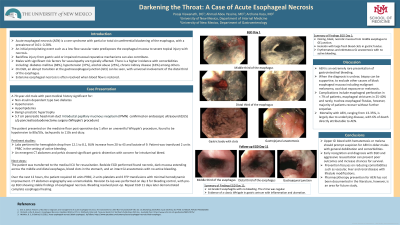Sunday Poster Session
Category: Esophagus
P0533 - Darkening the Throat: A Case of Acute Esophageal Necrosis
Sunday, October 27, 2024
3:30 PM - 7:00 PM ET
Location: Exhibit Hall E

Has Audio
- PV
Pooja Viswanath, MS, DO
University of New Mexico
Albuquerque, NM
Presenting Author(s)
Pooja Viswanath, MS, DO, Ahmad Abou Yassine, MD, Archana Kaza, MD
University of New Mexico, Albuquerque, NM
Introduction: Acute esophageal necrosis (AEN) is a rare syndrome with partial or total circumferential blackening of the esophagus, with a prevalence of 0.01- 0.28%. An initial precipitating event such as a low flow vascular state predisposes the esophageal mucosa to severe topical injury with necrosis. This is often observed in the distal third of the esophagus.
Case Description/Methods: A 70-year-old male with a history of non-insulin dependent diabetes, hypertension, hyperlipidemia, benign prostatic hypertrophy and prostate cancer presented post-operative day 1 after an uneventful Whipple’s, found to be hypotensive to 80s/50s, tachycardic to 110s and dizzy. Labs pertinent for hemoglobin drop from 12.1 to 8.1, BUN increase from 20 to 43 and lactate of 9. Patient was transfused 2 units PRBC. An emergent CT abdomen and pelvis showed significant gastric distention with concern for intraluminal bleed. The patient was transferred to the medical ICU for resuscitation. Bedside EGD performed found necrotic, dark mucosa extending across the entire esophagus, blood clots in the stomach, and an intact GJ anastomosis with no active bleeding. Over the next 12 hours, the patient required 10 units PRBC, 2 units platelets and 6 FFP transfusions with minimal hemodynamic improvement. CT abdomen angiography was unremarkable. Revision Ex-lap was performed on day 3 for bleeding control, with pre-op EGD showing stable findings of esophageal necrosis. Bleeding resolved post-op. Repeat EGD 11 days later demonstrated complete esophageal healing.
Discussion: AEN is an extremely rare presentation of gastrointestinal bleeding. The combination of pre-existing vasculopathy, an acute low flow state, and increased oxygen demand leads to necrosis. Early recognition and diagnosis with EGD with aggressive resuscitation prevent poor outcomes. Complications include esophageal perforation in < 7% of patients, esophageal strictures in 25-40% and rarely, trachea-esophageal fistulas, however, majority of patients recover without further sequelae. Mortality with AEN, ranging from 13-35%, is largely due to underlying disease, with 6% of death directly attributable to AEN. Prevention focuses on reducing comorbidities such as vascular, liver and renal disease with lifestyle modifications. Medical prevention for AEN has not been documented in the literature, however, is an area for future study.
Disclosures:
Pooja Viswanath, MS, DO, Ahmad Abou Yassine, MD, Archana Kaza, MD. P0533 - Darkening the Throat: A Case of Acute Esophageal Necrosis, ACG 2024 Annual Scientific Meeting Abstracts. Philadelphia, PA: American College of Gastroenterology.
University of New Mexico, Albuquerque, NM
Introduction: Acute esophageal necrosis (AEN) is a rare syndrome with partial or total circumferential blackening of the esophagus, with a prevalence of 0.01- 0.28%. An initial precipitating event such as a low flow vascular state predisposes the esophageal mucosa to severe topical injury with necrosis. This is often observed in the distal third of the esophagus.
Case Description/Methods: A 70-year-old male with a history of non-insulin dependent diabetes, hypertension, hyperlipidemia, benign prostatic hypertrophy and prostate cancer presented post-operative day 1 after an uneventful Whipple’s, found to be hypotensive to 80s/50s, tachycardic to 110s and dizzy. Labs pertinent for hemoglobin drop from 12.1 to 8.1, BUN increase from 20 to 43 and lactate of 9. Patient was transfused 2 units PRBC. An emergent CT abdomen and pelvis showed significant gastric distention with concern for intraluminal bleed. The patient was transferred to the medical ICU for resuscitation. Bedside EGD performed found necrotic, dark mucosa extending across the entire esophagus, blood clots in the stomach, and an intact GJ anastomosis with no active bleeding. Over the next 12 hours, the patient required 10 units PRBC, 2 units platelets and 6 FFP transfusions with minimal hemodynamic improvement. CT abdomen angiography was unremarkable. Revision Ex-lap was performed on day 3 for bleeding control, with pre-op EGD showing stable findings of esophageal necrosis. Bleeding resolved post-op. Repeat EGD 11 days later demonstrated complete esophageal healing.
Discussion: AEN is an extremely rare presentation of gastrointestinal bleeding. The combination of pre-existing vasculopathy, an acute low flow state, and increased oxygen demand leads to necrosis. Early recognition and diagnosis with EGD with aggressive resuscitation prevent poor outcomes. Complications include esophageal perforation in < 7% of patients, esophageal strictures in 25-40% and rarely, trachea-esophageal fistulas, however, majority of patients recover without further sequelae. Mortality with AEN, ranging from 13-35%, is largely due to underlying disease, with 6% of death directly attributable to AEN. Prevention focuses on reducing comorbidities such as vascular, liver and renal disease with lifestyle modifications. Medical prevention for AEN has not been documented in the literature, however, is an area for future study.
Disclosures:
Pooja Viswanath indicated no relevant financial relationships.
Ahmad Abou Yassine indicated no relevant financial relationships.
Archana Kaza indicated no relevant financial relationships.
Pooja Viswanath, MS, DO, Ahmad Abou Yassine, MD, Archana Kaza, MD. P0533 - Darkening the Throat: A Case of Acute Esophageal Necrosis, ACG 2024 Annual Scientific Meeting Abstracts. Philadelphia, PA: American College of Gastroenterology.
